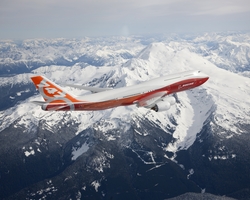- Latest Edition June 26th: Paris Air Show orders
- June 12th edition: Positive market sentiments ahead of Paris 2025
- May 29th Edition: AWG's tariff recommendations
- May 15th Edition: Mega orders show long term optimism
- Latest Edition May 1st: Tariffs: a win-win solution for aircraft
- April 17th Edition: Tariffs on aircraft - delay and hope
|
777x and the future of widebody jets
The decision by Boeing's Board to move ahead with the development of the twin jet widebody 777X asks some important questions about the future of long haul widebody jets.
This new airplane, with all new engines and a wingspan that exceeds that of the current B747-8, addresses a range of markets that could otherwise be served by four engined A380s and B747s. With a seat capacity of about 400, and a range of up to 9,500 miles, the 777X provides improved fuel efficiency while adding range in comparison to its four engined peers. This begs the question as to whether or not the 777X, and its Airbus competitor the A350-1000 threaten the commercial viability of their larger four engined peers.
Boeing is rolling out the 777X in response to a number of factors; (1) sustained pressure from important global clients to develop a twin jet of this scale; (2) the commercial launch of the 787 which frees up R&D resources for new airplane programmes; (3) the engine, carbon lightweight technology and wing advances secured in the 787 launch which can be brought to bear on the 777X, and; (4) the need to respond to Airbus' development of larger A350 versions. These factors have helped prompt action by Boeing to formally offer the 777X to customers. It also marks another aircraft from the Boeing family that is an iteration of an existing model instead of an all new airplane. The 737 MAX and 747-8 are both developments of existing successful aircraft whereas the 787 was an all new aircraft. In evolving an existing and highly successful platform Boeing is probably de-risking the 777X compared to the costs and risks undertaken in developing the 787. Financiers, and especially mainstream lessors, will closely examine the 777X as its sister ship 777s have evolved as highly successful components of a number of investment portfolios. Already, it appears Emirates could emerge as a key launch customer for the 777X. It operates over 190 B777s in its long haul fleet and the X could be a natural replacement for many of these. It will also be interesting to monitor how Emirates manages both its B777 and A380 fleets as it is the largest global customer for both. Developing a network that exploits the characteristics of both aircraft types will be an important pointer for other world airlines about the relative merits of widebody new generation two and four engined jets. For Boeing this is also a key move that will force airlines to make hard commercial decisions about the scale of aircraft needed for their existing and planned networks. Will the 777X provide a compelling product for long haul high capacity routes and in so doing displace the market opportunity for the B747-8? With sales of the latter struggling to reach levels that make the programme a commercial success, an extended and successful sales campaign for the 777X could make the 747-8 a marginal jet in the hyper competitive long haul marketplace. Financiers, and especially mainstream lessors, will closely examine the 777X as its sister ship 777s have evolved as highly successful components of a number of investment portfolios. While lessor demand for the A380 and B747 has remained relatively weak, could the 777X become a major wide body asset for inclusion in investment decisions? May 9th 2013. |

